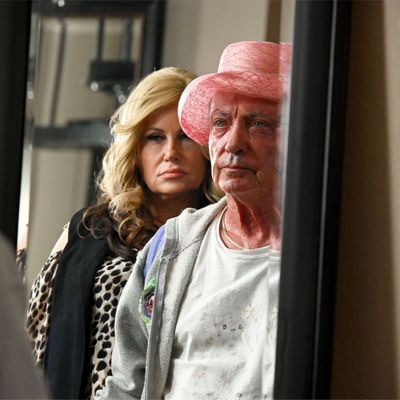
Pat Pitsenbarger (Udo Kier) is a former hairstylist and current resident of a Sandusky, Ohio, nursing home who spends his Social Security checks on illicit cigarettes and his days precisely refolding the napkins he steals from the dining hall. It’s a dreary existence, but it’s his, and when a lawyer stops by on behalf of the estate of Rita Parker-Sloan, a local socialite who was once Pat’s most important client, with an offer of $25,000 for one last posthumous spruce-up, Pat says no. More accurately, he hisses that they should “bury her with bad hair,” while slowly reclining in his armchair. Pat hasn’t had any power to flex in a long time, and he makes the most of the opportunity. Later that night, feeling sentimental and lonely, he has a change of heart, and the next morning, he packs up what little money he has, and the set of rings he used to wear on every finger, and stages an entirely unnecessary escape. As another resident points out, as Pat sets off across town, the door to leave isn’t locked.
Swan Song was written and directed by Todd Stephens, whose previous films include Another Gay Movie and Another Gay Sequel: Gays Gone Wild! — credits that, alongside the prospect of Kier as a flamboyant senior citizen blazing a trail through a quiet midwestern town, portend something broader and sillier than the movie that actually unfolds. Swan Song is a tremendously tender love letter to someone who survived so many of the slings and arrows that accompanied being an openly gay man in a small, conservative area. Having made it to old age, where he endures indignities like velcro sneakers, Pat finds himself without the disapproval he was accustomed to enduring but also without the community he so adored that formed in spite of it. The picaresque journey Pat takes across Sandusky isn’t the result of a plot device — as soon as he leaves the nursing home, he encounters a handsome young man, into whose arms he contrives a way to briefly fall, and is offered a ride to the funeral home that he turns down. Pat needs to pick up supplies and make a shopping list that serves as an excuse for him to return to all his old haunts, like the ghost of so many drag nights past.
Everyone responds with kindness, or at least equanimity, to Pat’s slightly out-of-practice outrageousness. A woman with “Jesus Is My Copilot” on her air freshener listens to his jumbled life story while taking him to the cemetery and gives his hand a squeeze before heading on her way. A couple who moved onto the plot of land Pat once shared with his partner, David, who died of AIDS, offer him the one artifact remaining from the old house, which was demolished. A woman who came to his shop once to have her hair dyed blonde outfits Pat in clothes from her store. Swan Song isn’t flawless — it gets off to a bumpy start, and it is worth examining that all of the Black characters in the film are the exact same flavor of sassy. But it eschews sentimentality in favor of an unapologetic bittersweetness. Only now, after everyone Pat loved is gone and he lost his business to homophobia and his home to laws that have since been changed, is everyone in town ready to salute Pat as a legend. Pat, it turns out, loved Rita too, despite the fact that she was a difficult, demanding Republican socialite — after all, Pat is a difficult, demanding socialite himself. The way the painful arc of their relationship is revealed through encounters with Rita’s nephew, Dustin (Michael Urie), and Pat’s old assistant, Dee Dee (Jennifer Coolidge), is beautifully done.
It’s the 76-year-old Kier’s tremendous performance that centers the movie (the character was inspired by a real Pat Pitsenbarger that Stephens knew when he was growing up in Sandusky). It’s Kier who renders incidental the unaddressed question of how this German man ended up in Sandusky in the first place. A young beauty who appeared in Andy Warhol’s Frankenstein and worked with Rainer Werner Fassbinder and Dario Argento, he went on to establish a career for himself as a professional eccentric in American films, to the point where that may have eclipsed casual awareness of his identity as a queer performer. But in Swan Song, he links both with an illuminating precision, playing Pat’s outsize persona as an ongoing performance, serving as armor and as a challenge to everyone he meets. Kier also shows how Pat’s out of practice with it, letting his vulnerabilities and his underbelly show, only to find that no one around is inclined to attack anymore. Pat doesn’t need to fight anymore, though that fight is what led him and his friends to build the town’s small gay bar, at which Pat used to perform, and which is about to close. It was born out of a need to have a safe place, and Swan Song manages to mourn that loss while acknowledging the progress that allowed it — ultimately serving as an elegy not just for a character, but for the community he used to be a part of.
More Movie Reviews
- The Thriller Drop Is a Perfect Addition to the Bad-First-Date Canon
- The Accountant 2 Can Not Be Taken Seriously
- Another Simple Favor Is So Fun, Until It Gets So Dumb


